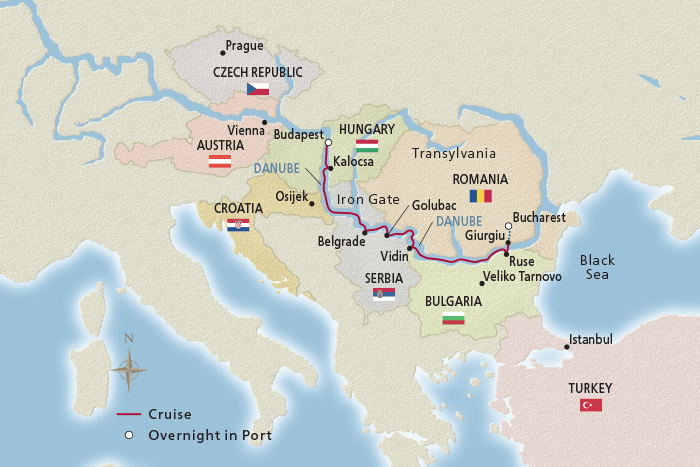Find the River Cruise you’re looking for...
11 Day Viking River Cruise from Budapest to Bucharest 2027

Passage to Eastern Europe
River Cruise Description
See Bucharest’s 3,000-room Palace of Parliament. Make banitsa bread with a home cook in Vidin. Explore Belgrade’s Ottoman and European treasures, including the 6th-century Kalemegdan Fortress. View the Danube’s towering Iron Gate. Witness Hungary’s daredevil Puszta horsemen. Behold Budapest’s grandeur. Once hidden behind the Iron Curtain, the eastern Danube still has secrets to reveal on this enriching cruisetour.Get More Cruise Info
We'd love to connect with you and answer any questions you might have about this cruise. Fill out the form below and we'll get back with you pronto.
* Required fields.
(Note: either your Email or Phone is required—not both.)
| Departure Date | Ship | Priced From (per person) | |
|---|---|---|---|
| Mar 15, 2027 | Viking Ullur | $4,299 | Call Us! |
| Mar 29, 2027 | Viking Ullur | $4,499 | Call Us! |
| Apr 12, 2027 | Viking Ullur | $4,599 | Call Us! |
| Apr 26, 2027 | Viking Ullur | $4,799 | Call Us! |
| May 10, 2027 | Viking Ullur | $4,999 | Call Us! |
| May 17, 2027 | Viking Vidar | $5,299 | Call Us! |
| May 24, 2027 | Viking Ullur | $4,999 | Call Us! |
| May 31, 2027 | Viking Lif | $4,999 | Call Us! |
| Jun 7, 2027 | Viking Ullur | $4,799 | Call Us! |
| Jun 14, 2027 | Viking Lofn | $4,699 | Call Us! |
| Jun 21, 2027 | Viking Ullur | $4,499 | Call Us! |
| Jun 28, 2027 | Viking Vidar | $4,499 | Call Us! |
| Jul 5, 2027 | Viking Ullur | $4,499 | Call Us! |
| Jul 12, 2027 | Viking Lif | $4,499 | Call Us! |
| Jul 19, 2027 | Viking Ullur | $4,499 | Call Us! |
| Jul 26, 2027 | Viking Lofn | $4,499 | Call Us! |
| Aug 2, 2027 | Viking Ullur | $4,299 | Call Us! |
| Aug 9, 2027 | Viking Vidar | $4,299 | Call Us! |
| Aug 16, 2027 | Viking Ullur | $4,499 | Call Us! |
| Aug 23, 2027 | Viking Lif | $4,499 | Call Us! |
| Aug 30, 2027 | Viking Ullur | $4,599 | Call Us! |
| Sep 6, 2027 | Viking Lofn | $4,999 | Call Us! |
| Sep 13, 2027 | Viking Ullur | $5,299 | Call Us! |
| Sep 20, 2027 | Viking Vidar | $5,299 | Call Us! |
| Sep 27, 2027 | Viking Ullur | $4,999 | Call Us! |
| Oct 4, 2027 | Viking Lif | $4,799 | Call Us! |
| Oct 11, 2027 | Viking Ullur | $4,599 | Call Us! |
| Oct 18, 2027 | Viking Lofn | $4,499 | Call Us! |
| Oct 25, 2027 | Viking Ullur | $4,499 | Call Us! |
| Nov 1, 2027 | Viking Vidar | $4,499 | Call Us! |
River Cruise Itinerary
Day-By-Day



Day 1 Budapest, Hungary
Arrive and check in to your hotel. Riverside beauty and a vibrant cultural scene blend together in Budapest to form one of Europe’s most rewarding cities. Hungary’s enchanting capital straddles the banks of the Danube, with traditional hillside Buda on one side and modern Pest on the other. By day, stunning art nouveau buildings, stalwart castles and grand palaces set the stage for inspiring strolls and long soaks in thermal spas. By night, the shimmering lights of the Parliament building dance across the waters of the Danube, the Chain Bridge uniting it all as a dramatic centerpiece.Day 2 Budapest, Hungary
Budapest’s old town is a fascinating medieval patchwork of narrow streets and colorful houses. In the Castle District, the Matthias Church soars in Gothic glory. Adjacent, the expansive wall and seven turrets of Fisherman’s Bastion overlook the Danube, the graceful Chain Bridge and the Pest side of the river. The centerpiece of the district is the sprawling Buda Castle. Constructed in the 13th century and expanded to its current baroque splendor during the 18th century, this edifice was home to Hungary’s kings for almost 700 years.Day 3 Budapest, Hungary
After breakfast, check out of your hotel.Transfer to your ship and settle into your stateroom. During the 12th century, the first Jewish settlers arrived in Buda from neighboring German and Slavic countries. Over the next hundreds of years, the community played an important role in the cultural and economic development of Hungary. But, like elsewhere in Europe, life for Jews alternated between periods of prosperity and persecution. More than 100,000 perished during the Holocaust, and a number of Budapest’s landmarks serve as a reminder of the events that took place. One of the most poignant memorials is the 60 pairs of cast-iron shoes that line the banks of the Danube River. They represent the men, women and children who fell there at the hands of the Hungarian Nazi Arrow Cross Party.Day 4 Kalocsa, Hungary
Once the seat of the archbishop, the cultural center of Kalocsa is more than 1,000 years old. The quaint town, surrounded by 8,000 acres of farmland growing fiery red peppers, is brimming with traditional Hungarian culture and steeped in the piquant flavors of paprika, the “red gold” that has been giving local goulash its distinctive taste for centuries. The world’s first Paprika Museum chronicles the spice’s history. The streets are adorned with bright murals of floral motifs, which create a cheery ambience for browsing craft-filled shops. Hungary’s artistic heritage takes center stage at the House of Folk Arts museum.Day 5 Osijek, Croatia
The fourth-largest city in Croatia, Osijek is located near the confluence of the Drava and Danube Rivers. It is the largest city and the economic and cultural capital of the eastern Croatian region of Slavonia. In its early days, Osijek was a Roman settlement called Mursa Maior (“major”). It was later rebuilt by the Ottomans and ruled by the Hapsburg Empire. Today, with an abundance of farmland and game, as well as plentiful baroque architecture and musical and outdoor venues, Osijek has become a gastronomic and cultural center of Croatia. Its cathedral can host 3,000 people.Day 6 Belgrade, Serbia
The Serbian capital and former capital of the state of Yugoslavia, Belgrade is one of the oldest cities in Europe. Its location at the confluence of the Sava and Danube Rivers has long made it a contested region. Throughout its history, the “White City,” as its Serbian name translates, has been destroyed and rebuilt 20 times. Fortunately, the wide-reaching citadel remains, housing the Kalemegdan Fortress, Orthodox churches, Turkish baths and green parkland. Its Church of St. Sava is one of the largest Orthodox buildings in the world.Day 7 Golubac, Serbia
Millennia of history await at “the Town of Doves,” the gateway to the Djerdap National Park. The Iron Gate of the Danube lies between the mighty Carpathian and Balkan Mountains, its dramatic scenery carved by narrow ravines. Guarding the Danube is the imposing 14th-century Golubac Fortress, which has seen ruling empires vie for its control over the centuries, changing hands between the Serbs, Hungarians, Bulgarians and Turks. Serbian culture is swathed in tradition, and it is an integral part of the country’s identity that has carried its people through challenging times in history. Ancient civilizations to modern empires have left their mark, creating a unique, fascinating heritage that spans thousands of years.Day 8 Vidin, Bulgaria
One of Bulgaria’s oldest riverside towns, Vidin is home to the only entirely preserved medieval Bulgarian castle. Perched impressively on the riverbank, its striking pose, thick ring walls, stout towers and solid gates form a fortress known as Babini Vidini Kuli, which means Granny Vida’s Towers. Around the castle rose a fairy-tale town of 25 minarets, domes and other charming architecture of the period. Though many of these features have been shadowed by today’s city, Vidin retains its charms. Today it is largely an agricultural and trade center renowned for its wines.Day 9 Ruse, Bulgaria
The most integral Danube city in Bulgaria, Ruse enjoys a setting amid a rolling countryside blanketed in sunflower and wheat fields. Once an outpost of the Roman Empire, it was known as Sexaginta Prista, or Sixty Ships, for the fleet that once docked here. Today, it is more known for its colorful atmosphere and as a gateway to Romania’s fabled Transylvania region. Best explored on foot, the city features many fine examples of 19th- and 20th-century neobaroque and neorococo architecture.Day 10 Bucharest, Romania
After breakfast, disembark your ship and transfer to your destination.Arrive and check in to your hotel. Bucharest is Romania’s cultural capital. Its original fortress, the first of many, was built to protect the Walachian state from the Turks. Today, it is a city of elegant French-style boulevards, lush gardens and green expanses, including the tranquil Bucharest Botanical Garden. The historic Lipscani district exudes the old-world charms of cobblestone alleys, inns and shops. The sprawling Palace of Parliament is the world’s largest civilian building, said to contain 3,000 rooms.Day 11 Bucharest, Romania
Communism changed the face of Bucharest and has left in its wake a city brimming with imposing socialist architecture. Dotted among today’s cityscape are wonderful art nouveau buildings, ancient churches and monasteries that were rescued from the bulldozer. From the 18th-century church Schitul Maicilor to the 16th-century Mihai Vodă Church, it is best to discover these treasures on foot. Bucharest is also home to an array of world-class museums, including the George Enescu National Museum, which features a beautiful oyster-shaped glass awning. Bid farewell to your fellow guests and journey home. Or spend more time exploring, perhaps joining one of our extensions.Having trouble deciding which cruise is right for you?

